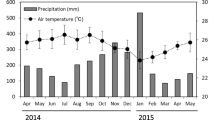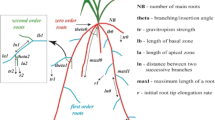Abstract
Quantifications of root system architecture and growth dynamics became essential in sustainable agriculture, bio-engineering and underground ecology in general. Assessing of root architectural parameters is still challenging also owing to different methodological challenges and high-cost facilities required. The objective of this study was to design and examine a performance of a simple experimgal set-up for monitoring and analyses of root system architecture. The proposed system was examined with two cover crops — white mustard and sweet clover — grown in sand filled pots under controlled climate conditions for several weeks. Root systems of each crop were harvested in regular intervals of 2 to 3 weeks in 3 to 4 replicates. After careful washing, the intact root systems were photo captured in water filled cylinder in their quasi-natural position over entire rotation and then scanned using a flatbed professional scanner. The gained images (photos and scans) were analysed with AutoCAD and WinRhizo software for measuring of diverse root architectural parameters for modelling. The results showed that the selected experimental and methodical approaches were appropriate for monitoring and delivering data of good quality. Both, digital camera and scanner were regarded as essential complementary imaging tools for correct assessment of the root system architecture. To maximise the accuracy of the measurements, recommendation for improving the system were provided. Extracted root data are intended for parametrisation of root architectural models, but they also support researcher and experts in their efforts to improve crop uptake efficiency in sustainable agriculture and for bio-engineering purposes.
Similar content being viewed by others
References
AutoCAD 2014. Autodesk University (https://doi.org/www.autodesk.de/)
Bardgett R.D., Mommer L. & De Vries F.T. 2014. Going underground: root traits as drivers of ecosystem processes. Trends Ecol. Evol. 29: 692–699.
Bengough A.G., Gordon D.C., Al-Menaie H., Ellis R.P., Allan D., Keith R., Thomas W.T.B. & Forster B.P. 2004. Gel observation chamber for rapid screening of root traits in cereal seedlings. Plant Soil 262: 63–70.
Bodner G., Leitner D., Nakhforoosh A., Sobotik M., Moder K. & Kaul H.-P. 2013a. A statistical approach to root system classification. Front. Plant Sci. 4: 292. doi: 10.3389/fpls.2013.00292
Bodner G., Scholl P., Loiskandl W. & Kaul H.-P. 2013b. Environmental and management influences on temporal variability of near saturated soil hydraulic properties. Geoderma 204-205: 120–129.
Clark R.T., Famoso A.N., Zhao K., Shaff J.E., Craft E.J., Bus-tamante C.D., McCouch S.R., Aneshansley D.J. & Kochian L.V. 2013. High-throughput two-dimensional root system phenotyping platform facilitates genetic analysis of root growth and development. Plant Cell Environ. 36: 454–466.
Diggle A.J. 1988. ROOTMAP-a model in three-dimensional coordinates of the growth and structure of fibrous root systems. Plant Soil 105: 169–178.
Downie H.F., Adu M.O., Schmidt S., Otten W., Dupuy L.X., White P.J. & Valentine T.A. 2015. Challenges and opportunities for quantifying roots and rhizosphere interactions through imaging and image analysis. Plant Cell Environ. 38: 1213–1232.
Dunbabin V., Postma J., Schnepf A., Pagès L., Javaux M., Wu L., Leitner D., Chen Y., Rengel Z. & Diggle A. 2013. Modelling root-soil interactions using three-dimensional models of root growth, architecture and function. Plant Soil 372: 93–124.
Dunbabin V., Rengel Z. & Diggle A. 2004. Simulating form and function of root systems: efficiency of nitrate uptake is dependent on root system architecture and the spatial and temporal variability of nitrate supply. Funct. Ecol. 18: 2004–2211.
Dunbabin V.M., Diggle A.J., Rengel Z. & van Hugten R. 2002. Modelling the interactions between water and nutrient uptake and root growth. Plant Soil 239: 19–38.
Dupuy L., Gregory P.J. & Bengough A.G. 2010. Root growth models: towards a new generation of continuous approaches. J. Exp. Bot. 61: 2131–2143.
Haeusler C. & Pucher D.R. 2014. Parametrisierung des Wurzelsystems von Gelbem Steinklee und Gelbsenf. Bachelor thesis, Univ. of Natural Resources and Life Sciences, Vienna, 30 pp.
Heppell J., Talboys P., Payvandi S., Zygalakis K.C., Fliege J., Withers P.J.A., Jones D.L. & Roose T. 2015. How changing root system architecture can help tackle a reduction in soil phosphate (P) levels for better plant P acquisition. Plant Cell Environ. 38: 118–128.
Himmelbauer M.L., Loiskandl W. & Kastanek F. 2004. Estimating length, average diameter and surface area of roots using two different Image analyses systems. Plant Soil 260: 111–120.
Himmelbauer, M.L., Loiskandl, W. & Rousseva, S. 2010. Spatial root distribution and water uptake of maize grown on field with subsoil compaction. J. Hydrol. Hydromech. 58: 163–174.
Himmelbauer M.L., Vateva V., Lozanova L., Loiskandl W. & Rousseva S. 2013. Site effects on root characteristics and soil protection capability of two cover crops grown in South Bulgaria. J. Hydrol. Hydromech. 61: 30–38.
Judd L.A., Jackson B.E. & Fonteno W.C. 2015. Advancements in root growth measurement technologies and observation capabilities for container-grown plants. Plants 4: 369–392.
Klement R., Fér M., Novotná Š., Nikodem A. & Kodešová R. 2016. Root distributions in a laboratory box evaluated using two different techniques (gravimetric and image processing) and their impact on root water uptake simulated with HY-DRUS. J. Hydrol. Hydromech. 64: 196–208.
Lee Ch. & Rawlings J.O. 1982. Design of experiments in growth chambers — uniformity trials in the North Carolina State University Phytotron. Crop Science 22: 551–558
Leitner D., Felderer B., Vontobel P. & Schnepf A. 2014. Recovering Root System Traits Using Image Analysis Exemplified by Two-Dimensional Neutron Radiography Images of Lupine. Plant Physiol. 164: 24–35.
Leitner D., Klepsch S., Bodner G. & Schnepf A. 2010. A dynamic root system growth model based on L-Systems: Tropisms and coupling to nutrient uptake from soil. Plant Soil 332: 177–192.
Lobet G., Draye X. & Périlleux C. 2013. An online database for plant image analysis software tools. Plant Methods 9: 38. https://doi.org/www.plant-image-analysis.org/ (accessed 28.12.2016).
Lobet G., Pound M.P., Diener J., Pradal C., Draye X., Godin C., Javaux M., Leitner D., Meunier F., Nacry P., Pridmore T.P. & Schnepf A. 2015. Root System Markup Language: toward an unified root architecture description language. Plant Physiol. 167: 617–627
Lynch J. 1995. Update on root biology: Root architecture and plant productivity. Plant Physiol. 109: 7–13.
Lynch J.P. 2007. Roots of the second green revolution. Austral. J. Bot. 5: 493–512
Lynch J., Nielsen K.L., Davis R.D. & Jablokow A.G. 1997. Sim-root: modelling and visualization of root systems. Plant Soil 188: 139–151.
Meier U. 1997. Phenological growth stages and BBCH-identification keys of weed species. p. 135–139. In: Growth Stages of Monoand Dicotyledonous Plants. BBCH Monograph. Berlin, Wien. Blackwell Wissenschafts-Verlag, 622 pp.
Metzner R., Eggert A., van Dusschoten D., Pflugfelder D., Gerth S., Schurr U., Uhlmann N. & Jahnke S. 2015. Direct comparison of MRI and X-ray CT technologies for 3D imaging of root systems in soil: potential and challenges for root trait quantification. Plant Methods 11: 11–17.
Pagès L., Jordan M. & Picard D. 1989. A simulation model of the three-dimensional architecture of the maize root system. Plant Soil 119: 147–154.
Pagès L., Vercambre G., Drouet J., Lecompte F., Collet C. & Le Bot J. 2004. RootTyp: a generic model to depict and analyse the root system architecture. Plant Soil 258: 103–119.
Schreiner J. & Panzenboeck F. 2014. Parametrisierung des Wurzelsystems von Steinklee. Bachelor thesis, Univ. of Natural Resources and Life Sciences, Vienna, 26 pp.
Stokes A., Atger C., Bengough A.G., Fourcaud T. & Sidle R.C. 2009. Desirable plant root traits for protecting natural and engineered slopes against landslides. Plant Soil 324: 1–30
Timlin D. & Ahuja L.R. 2013. Enhancing Understanding and Quantification of Soil-Root Growth Interactions. Series: Advances in Agricultural Systems Modeling. American Society of Agronomy, Madison, WI, USA, 324 pp. ISBN-10: 0891183388; ISBN-13: 978-0891183389
Tron S., Bodner G., Laio F., Ridolfi L. & Leitner D. 2015. Can diversity in root architecture explain plant water use efficiency? A modeling study root. Ecol. Model. 312: 200–210.
Wang J., Zhang X. & Wu C. 2015. Advances in experimental methods for root system architecture and root development. J. Forest Res. 26: 23–32.
WinRHIZO 2003. WinRHIZO software. Regent Instruments Inc., Quebec, Canada. www.regentinstruments.com
Zobel R.W. & Waisel Y. 2010. A plant root system architectural taxonomy: a framework for root nomenclature. Plant Biosyst. 144: 507–512.
Author information
Authors and Affiliations
Corresponding author
Rights and permissions
About this article
Cite this article
Himmelbauer, M.L., Scholl, P., Bodner, G. et al. Root system architecture — budget experimental system for monitoring and analyses. Biologia 72, 988–994 (2017). https://doi.org/10.1515/biolog-2017-0110
Received:
Accepted:
Published:
Issue Date:
DOI: https://doi.org/10.1515/biolog-2017-0110




